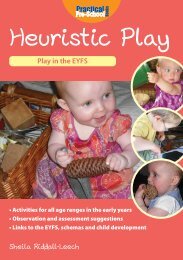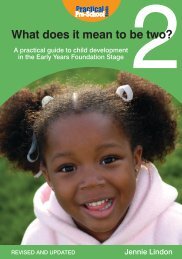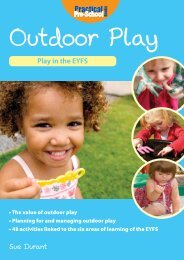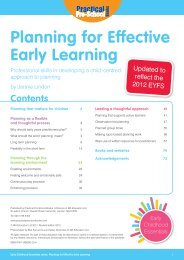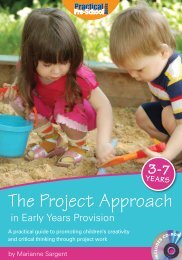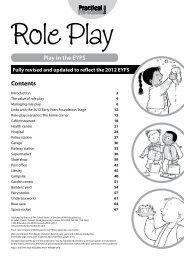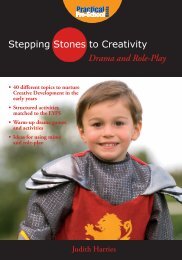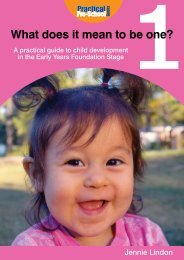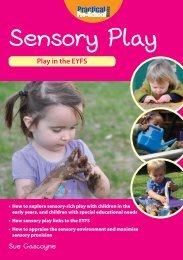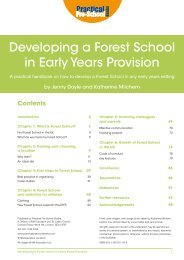Sustained Shared Thinking - Practical Pre-School Books
Sustained Shared Thinking - Practical Pre-School Books
Sustained Shared Thinking - Practical Pre-School Books
Create successful ePaper yourself
Turn your PDF publications into a flip-book with our unique Google optimized e-Paper software.
a problem, clarify a concept, evaluate an activity, extend a<br />
narrative etc. Both parties must contribute to the thinking<br />
and it must develop and extend the understanding.”<br />
(Siraj-Blatchford et al, 2004, p.vi).<br />
<strong>Sustained</strong> shared thinking is a key approach in helping children<br />
to become life-long learners with transferable skills. Children<br />
who have the ability to enquire, consider, reflect, reason,<br />
predict, evaluate and suggest creative solutions, will be better<br />
equipped to succeed in a world where a job is no longer for life;<br />
careers are constantly evolving, demanding adaptability and a<br />
flexible approach. <strong>Thinking</strong> skills and sustained individual and<br />
creative thought must be introduced early in order for children<br />
to develop as learners and thrive in the future.<br />
What is the project approach<br />
Early years practitioners will be familiar with the use of topics<br />
and themes when planning in early education. It is common<br />
practice to choose a new topic each half term and plan subjectrelated<br />
activities around the theme of animals or seasons. The<br />
chosen topic is used to create commonality between curriculum<br />
areas and allows children to gain some basic knowledge about<br />
the focus subject matter.<br />
The project approach involves planning to exploit an area of<br />
interest – which may stem from a topic – and using it as a basis<br />
for in-depth enquiry or research. Areas of learning are not<br />
simply linked by a theme, they are integrated as a result of the<br />
investigative process. Knowledge and skills are not taught in<br />
isolation, but rather acquired and practised within a meaningful<br />
context that makes sense to the children. For example,<br />
practitioners may plan a farm topic that aims to inform children<br />
about the various animals and foods that are bred and cultivated<br />
on a farm. In addition to this, practitioners might plan a range<br />
of farm themed activities aimed at teaching children skills in<br />
mathematics and literacy. For example, counting eggs produced<br />
by chickens or reading farm themed stories. In contrast, a<br />
project stemming from a provoking farm visit might be planned<br />
in response to the children’s interest in tractors. The children<br />
may be given the opportunity to investigate a real tractor and<br />
see a farmer demonstrate how it moves and works. This could<br />
lead to any number of different activities that incidentally cover<br />
a number of areas of learning. For example, the children may<br />
choose to draw pictures of tractors and label the different parts;<br />
they might create models of tractors with moving parts; or they<br />
might experiment with using tractors to dig sand, transport the<br />
sand, and fill containers. This could lead to an investigation into<br />
the purpose and use of tractors in the sand pit.<br />
Projects stem from the interests of the children and are<br />
planned or developed in collaboration with them. This is in<br />
contrast to topics that might have initially been suggested by<br />
the children but are ultimately planned and developed by<br />
adults to meet predetermined curriculum objectives.<br />
A project is started with an initial provocation that triggers<br />
conversation and debate. A provocation could be:<br />
• An event, e.g. a visit to the dentist or a village fête;<br />
• A question such as “why do pine cones open and close”<br />
or “how does a bicycle work”;<br />
• A picture, e.g. a famous artwork or a photograph of a puppet<br />
misbehaving;<br />
• An object, e.g. a tractor wheel or a foreign fruit.<br />
After the children have had some time to explore this<br />
provocation or trigger, they are gathered together to share their<br />
experiences and think about what they would like to find out or<br />
do next. The children’s questions and ideas are recorded and<br />
practitioners meet together to discuss and use these suggestions<br />
as a basis for planning the project. Practitioners then set up<br />
various resources around the setting that will help facilitate<br />
the children’s explorations. The children might investigate<br />
individually, in groups, or as a class and practitioners work<br />
alongside them to help develop and extend their ideas.<br />
The book, The Project Approach in Early Years Provision, explains<br />
how to plan and carry out a project and provides several case<br />
studies as examples. These include, planting a fake cocoon<br />
in a reception classroom to build on the children’s interest<br />
in butterflies; hiding a popular puppet, prompting a missing<br />
person’s investigation; and an alternative idea for encouraging<br />
nursery children to investigate freezing and melting.<br />
In her recent review of the EYFS Dame Tickell (2011)<br />
underlines the importance of active learning, and in<br />
particular playing and exploring. She explains that children<br />
learn through active investigation and it is through such<br />
concrete learning experiences that children have the<br />
opportunity to develop creative and critical thinking skills.<br />
How do projects promote the use of<br />
thinking skills<br />
In order to learn critical thinking skills children need to be<br />
given the opportunity to immerse themselves in a deeper<br />
thought process with the help of skilled practitioners:<br />
“All of us have the ability to think creatively, but the extent to<br />
which we do will probably be highly dependent on the quality of<br />
our earliest experiences … With the right stimulus and support<br />
2<br />
Using projects to promote sustained shared thinking by Marianne Sargent - Author of The Project Approach in Early Years Provision




